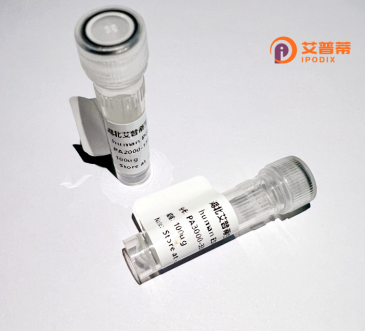
| 纯度 | >90%SDS-PAGE. |
| 种属 | Human |
| 靶点 | TTC8 |
| Uniprot No | Q8TAM2 |
| 内毒素 | < 0.01EU/μg |
| 表达宿主 | E.coli |
| 表达区间 | 1-541 aa |
| 活性数据 | MSSEMEPLLL AWSYFRRRKF QLCADLCTQM LEKSPYDQEP DPELPVHQAA WILKARALTE MVYIDEIDVD QEGIAEMMLD ENAIAQVPRP GTSLKLPGTN QTGGPSQAVR PITQAGRPIT GFLRPSTQSG RPGTMEQAIR TPRTAYTARP ITSSSGRFVR LGTASMLTSP DGPFINLSRL NLTKYSQKPK LAKALFEYIF HHENDVKTIH LEDVVLHLGI YPFLLRNKNH IEKNALDLAA LSTEHSQYKD WWWKVQIGKC YYRLGMYREA EKQFKSALKQ QEMVDTFLYL AKVYVSLDQP VTALNLFKQG LDKFPGEVTL LCGIARIYEE MNNMSSAAEY YKEVLKQDNT HVEAIACIGS NHFYSDQPEI ALRFYRRLLQ MGIYNGQLFN NLGLCCFYAQ QYDMTLTSFE RALSLAENEE EAADVWYNLG HVAVGIGDTN LAHQCFRLAL VNNNNHAEAY NNLAVLEMRK GHVEQARALL QTASSLAPHM YEPHFNFATI SDKIGDLQRS YVAAQKSEAA FPDHVDTQHL IKQLRQHFAM L |
| 分子量 | 61.5 kDa |
| 蛋白标签 | His tag N-Terminus |
| 缓冲液 | PBS, pH7.4, containing 0.01% SKL, 1mM DTT, 5% Trehalose and Proclin300. |
| 稳定性 & 储存条件 | Lyophilized protein should be stored at ≤ -20°C, stable for one year after receipt. Reconstituted protein solution can be stored at 2-8°C for 2-7 days. Aliquots of reconstituted samples are stable at ≤ -20°C for 3 months. |
| 复溶 | Always centrifuge tubes before opening.Do not mix by vortex or pipetting. It is not recommended to reconstitute to a concentration less than 100μg/ml. Dissolve the lyophilized protein in distilled water. Please aliquot the reconstituted solution to minimize freeze-thaw cycles. |
以下是关于重组人TTC8蛋白的3篇代表性文献:
1. **《BBS8. a ciliary protein essential for Bardet-Biedl syndrome, regulates cilia length via interactions with PCM-1」**
*作者:Nachury MV, et al.*
**摘要**:研究揭示了TTC8(BBS8)作为纤毛形成的关键调节因子,通过重组人TTC8蛋白证明了其与PCM-1的相互作用,并阐明了其在维持纤毛结构完整性中的功能。
2. **「Structural and functional characterization of recombinant TTC8 reveals its role in intraflagellar transport」**
*作者:Wei Q, et al.*
**摘要**:通过体外重组表达人TTC8蛋白,解析了其结构特征,发现其参与纤毛内运输复合体(IFT)的组装,并提出其在信号传导中的作用机制。
3. **「TTC8 mutations cause Bardet-Biedl syndrome through disrupted ciliary targeting of membrane proteins」**
*作者:Zhang Y, et al.*
**摘要**:利用重组TTC8蛋白进行功能验证,证明其在巴德-毕德综合征中的致病突变导致纤毛膜蛋白运输缺陷,进而引发细胞信号异常。
以上研究均围绕重组TTC8蛋白的功能、结构及疾病关联展开,可供进一步研究参考。
The TTC8 protein, also known as tetratricopeptide repeat domain 8. is encoded by the TTC8 gene in humans. It is a component of the BBSome complex, a conserved protein assembly critical for ciliary function and intracellular trafficking. TTC8 contains multiple tetratricopeptide repeats (TPRs), structural motifs mediating protein-protein interactions, which facilitate its role in recruiting cargo to the BBSome for transport within primary cilia. These hair-like organelles act as cellular signaling hubs, coordinating pathways like Hedgehog and GPCR-mediated signaling.
Mutations in the TTC8 gene are linked to Bardet-Biedl syndrome (BBS), a rare autosomal recessive disorder characterized by retinal degeneration, obesity, kidney abnormalities, polydactyly, and cognitive impairments. BBS-associated TTC8 variants disrupt ciliary trafficking, leading to dysfunctional signaling and cellular homeostasis. Recombinant human TTC8 protein is produced via heterologous expression systems (e.g., E. coli, mammalian cells) for functional studies. Its purification enables exploration of molecular interactions within the BBSome, ciliary transport mechanisms, and disease-related pathobiology. Research on recombinant TTC8 aids in elucidating its structural domains, post-translational modifications, and potential therapeutic targets for ciliopathies. Additionally, it serves as a tool for biochemical assays, antibody development, and screening compounds to modulate ciliary functions in genetic disorders.
×